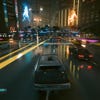DLSS 3.5 Ray Reconstruction successfully makes Cyberpunk 2077 very, very slightly prettier
Not the most earthshattering RTX trick, but one worth pulling
Cyberpunk 2077: Phantom Liberty is, according to our reviewer Graham, "perhaps the best expansion pack ever made." Feh, small potatoes – Phantom Liberty’s most prestigious achievement is surely how it heralds a new ray tracing feature that makes Cyberpunk 2077 look and run a tiny bit better. On specific settings. And only on GeForce RTX graphics cards. The more expensive ones.
Hello, then, to DLSS 3.5 and its Ray Reconstruction component. Like how DLSS improves visuals and performance with AI-aided upscaling and ant-aliasing, Ray Reconstruction injects some machine learning cleverness into the rendering of ray tracing. Nvidia say Ray Reconstruction cleans up artefacts and reduces the performance impact of RT effects, and judging by how it works in Cyberpunk 2077, I’d say they’re correct – with the caveat that all its enhancements are, ultimately, modest.
For the foreseeable future, they’ll also be limited to an exceptionally narrow group of games, and even to specific ray tracing settings within those games. To start with, DLSS 3.5 will only enjoy compatibility with games that have full path tracing, which is a more holistic but even more computationally expensive evolution of the RT effects you usually get in games. As of writing, the list of confirmed DLSS 3.5 games only extends to Cyberpunk 2077 (Phantom Liberty included), Portal with RTX, and Alan Wake 2, and what’s more, you’ll need to activate path tracing in all of them to even unlock Ray Reconstruction as an option. It simply won’t work with more basic ray tracing, though Nvidia have suggested it could in the future.
The better news, compatibility-wise, is that this is not another DLSS 3 frame generation situation where you’ll specifically need an RTX 40 series GPU. Despite the 3.5 version number, Ray Reconstruction can lean on a wider selection of compatible cards than DLSS 3, with every RTX-branded model back to the 20 series theoretically capable of enabling the new feature. Whether those older GPUs will also handle path tracing is, of course, a different matter.
Luckily, I had to hand a couple that will, in the RTX 4070 Ti and RTX 3070. With freshly updated drivers, Phantom Liberty dutifully installed on SSD, and Cyberpunk’s path-traced Overdrive mode engaged, I set out to see what a difference Ray Reconstruction makes in the time-honoured hardware blogging manner: staring at puddles.
In these particular puddles, we can see some of the more striking advantages to Nvidia’s AI-fuelled redrawing. With Ray Reconstruction, the reflection of the wall is clearer and generally more mirror-like, with the same quality visible on the bundle of weeds. With standard Overdrive path tracing, the reflection is blurred, as if out of focus. The edge of the bigger puddle is also more sharply detailed, with a clearer indication of where the dry tarmac ends and the water begins.
There’s more general lighting detail with Ray Reconstruction, too. Look at the little indents within the yellow road marking on the right: they appear flat with standard lighting, but Ray Reconstruction adds depth and texture by having light bounce off the vertical recesses.
On foot and up close, many of the differences remain minor, but they do exist. Again, the reflection in that pooled water is more detailed with Ray Reconstruction, and the light emitting from the nearest TV on the floor exhibits less visual noise, which in turn helps maintain the texture of the carpet underneath.
Ray Reconstruction even appears to make path-traced reflections more accurate, as well as sharper. If you click and zoom in on this next screenie, you’ll spot how the six-wheeled SUV speeding ahead has a reflection that only barely resembles itself; the front wheels don’t even appear connected to the ground. Flick on Ray Reconstruction and the next car, when it reaches the same position, is much more faithfully reflected. The wet ground effect generally looks nicer as well.
Sticking with the reflections-of-cars theme, these can mysteriously vanish with vanilla Overdrive settings – check out the car just on the right there. Ray Reconstruction restores them, which I’m fairly sure is down to how DLSS draws pixel data from previous frames to touch up new ones. Fast-moving objects can confuse ray tracing systems, but Ray Reconstruction benefits from feeding itself that extra data, keeping the simulation more accurate.
It’s hard to capture with screenshots, and probably with even a lightly compressed video embed, but I also noticed Cyberpunk 2077 just looked a teeny, tiny bit sharper in motion when Ray Reconstruction was switched on. That could be another positive effect of DLSS 3.5 replacing the standard denoising algorithms, which remove much of the fuzziness that ray tracing creates, but can overwhelm certain colour data in the process – dulling the edges of objects. I disabled motion blur while capturing all of this photo evidence, but with Ray Reconstruction, it was like cleaning away a small vestige of motion blur that I hadn’t previously noticed.
As for the promised performance increase, I generally saw smaller gains than Nvidia’s DLSS 3.5 marketing JPEGs suggested. Still, they were gains. In Cyberpunk 2077’s built-in benchmark tool, my RTX 4070 Ti averaged 95fps at 1440p with Overdrive mode, Balanced DLSS upscaling, and DLSS frame generation enabled. The addition of Ray Reconstruction saw that creep up to 99fps, so it’s a material rise even if it’s not one you’d immediately notice. These results held up in-game as well: I repeated a jog around Phantom Liberty’s new Dogtown district with the same settings, averaging 95fps with Ray Reconstruction and 90fps without.
Overdrive at 1440p is a bit much for the RTX 3070, so for this GPU I dropped to 1080p, keeping Balanced DLSS upscaling but unavoidably losing frame generation. Back in the benchmark, this setup averaged 51fps with Ray Reconstruction off, and 54fps with it on.
Obviously, these aren’t night-and-day differences, and neither are the visual improvements (unless you habitually glare at rugs or the underside of cars. I’m not your dad). But even if it’s to merely dinky extents, the fact is that DLSS 3.5 and Ray Reconstruction successfully upgrades fidelity and performance. Simultaneously, and with no readily apparent drawback outside of the narrow game and GPU support.
These are effective enthusiasm dampeners, no doubt, but I’d rather have a good PC feature that only works in three games over a crap one that works in three thousand. If Nvidia can get Ray Reconstruction up and running without the need for full path tracing, it could be another reason to make your next graphics card upgrade an RTX.


















